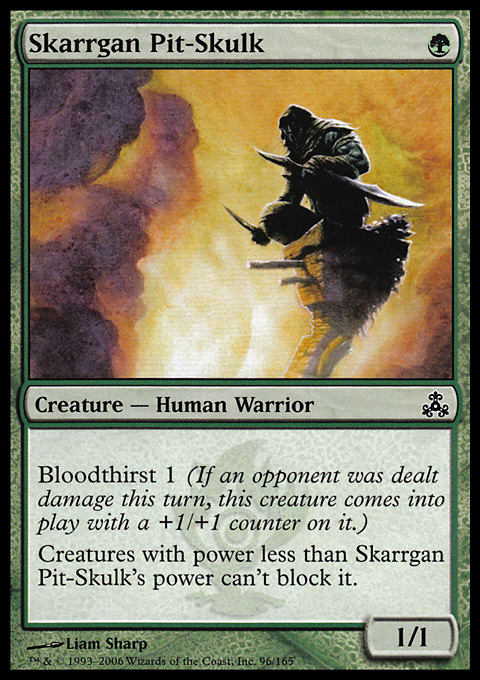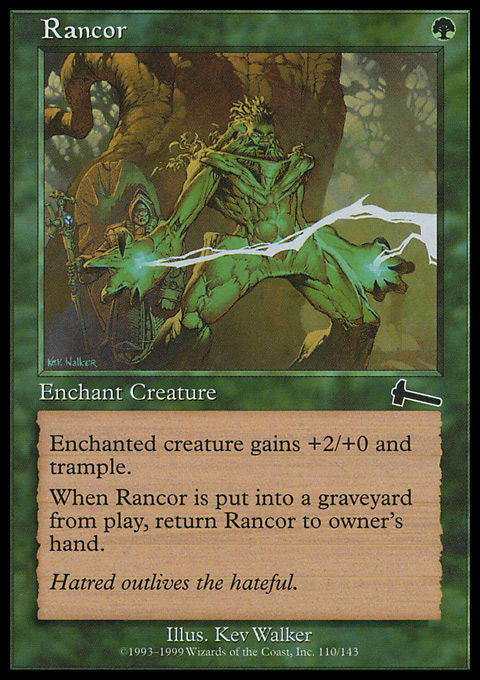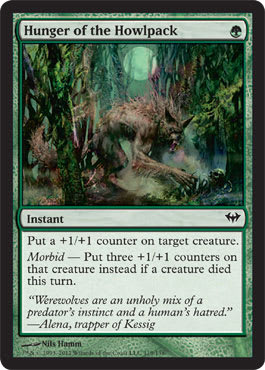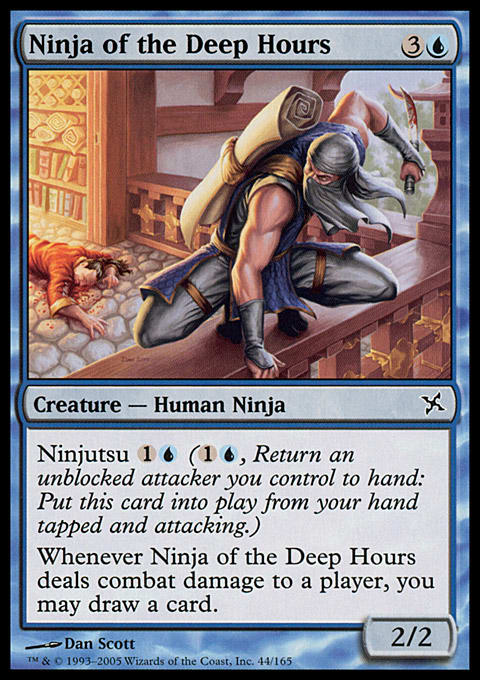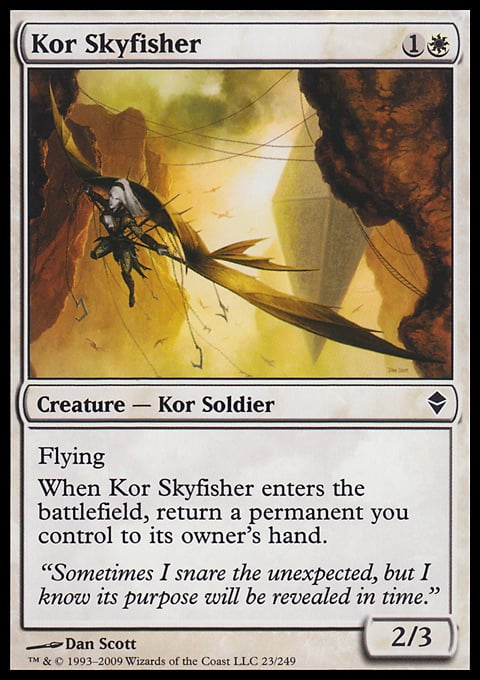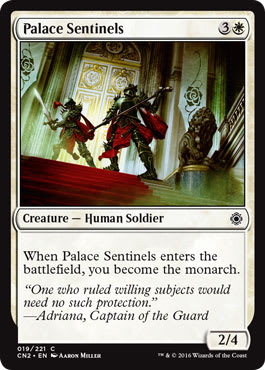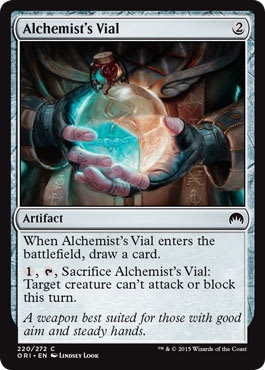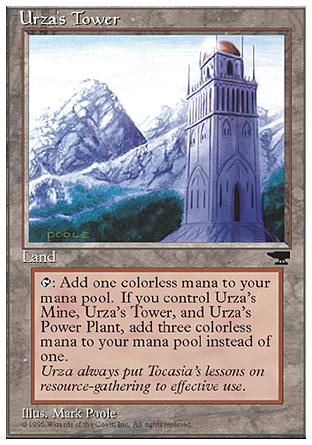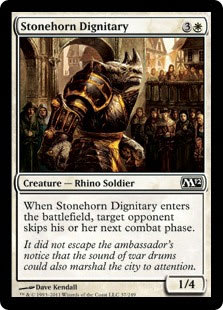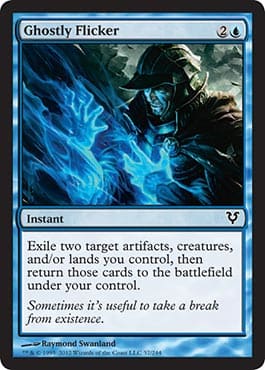Let's talk about the baseline of the Pauper metagame.
Four of the most consistently successful decks in Pauper are Izzet Delver, Boros Monarch, Mono-Green Stompy and Tron. But what is more interesting than the continued success of each of these decks is how each one of them represents a classic archetype in the Magic metagame: Stompy is a linear aggro deck; Izzet Delver is a disruptive aggro deck; Boros Monarch is a midrange deck; and Blue-based Tron, at least as it exists in Pauper, is a big mana control deck.
Each one of these decks fits neatly into a circular food chain within the Pauper metagame. Roughly speaking, in terms of favorability in matchups:
Izzet Delver beats Stompy beats Boros Monarch beats Tron beats Izzet Delver
Or, if we looked at how each of these decks represents their native archetype:
Linear Aggro beats Disruptive Aggro beats Control beats Midrange beats Linear Aggro.
The decks next to each other on the food chain have the most lopsided matchups; the decks across from each other have the closest matchups.
Each deck is both predator and prey. And so, when you choose a deck it is vitally important to consider how you are building your deck to beat the decks you both hope and expect to beat, and also how you hope to compete against the decks that are favored to beat you.
Let's take a look at each of these decks.
Stompy | Pauper | Lanterning, 4-3 in the 07-29-18 Pauper Challenge
- Creatures (27)
- 2 River Boa
- 3 Quirion Ranger
- 3 Silhana Ledgewalker
- 3 Vault Skirge
- 4 Burning-Tree Emissary
- 4 Nest Invader
- 4 Nettle Sentinel
- 4 Skarrgan Pit-Skulk
- Spells (33)
- 4 Hunger of the Howlpack
- 4 Vines of Vastwood
- 4 Elephant Guide
- 4 Rancor
- 17 Forests
- Sideboard (15)
- 4 Gleeful Sabotage
- 3 Epic Confrontation
- 3 Hidden Spider
- 2 Gut Shot
- 2 Viridian Longbow
- 1 Feed the Clan
Stompy is a textbook linear Aggro deck. The average converted mana cost of each of the 43 non-lands in the deck is 1.35, counting Vault Skirge as a 1-drop. But that doesn't account for both Burning-Tree Emissary and Nest Invader paying you back with mana as you play them, or for Quirion Ranger doubling as both a mana source and also a Vigilance-granting machine. There is no better deck in Pauper at converting mana investment to adding power to the board. Stompy, like its parent Aggro archetype, is a deck that fights out its wins and losses on the battlefield. It is always the beatdown. Stompy's goal is to keep presenting threats, to overwhelm the opponent with threats faster than their opponent can respond, and to punish the opponent for trying to answer their threats. Trying to beat Stompy with a bunch of Flame Slash and Chainer's Edict is a sucker's game. They'll beat you by stranding cards in your hand faster than you can play them. Instead, if you are going to beat Stompy, you need to meet them on the axis that they are trying to encroach as forcefully as possible: time. Because they lack long-term card advantage, the longer you can stretch out a game vs. Stompy, the greater your chance to win. You can do this via lifegain cards like Lone Missionary or by playing big blockers with card advantage like Augur of Bolas, or by trying to negate combat steps entirely with cards like Prismatic Strands, Moment's Peace or Stonehorn Dignitary.
Stompy's Predator: Boros Monarch loves to face Stompy because it matches their threats as quickly as they play them with the end goal of buying time for a more powerful late game. Kor Skyfisher is an incredible blocker for every threat in the Stompy assault, even Vault Skirge and Silhana Ledgewalker. Boros Monarch overloads on cheap removal, but it also is built to use all its mana even when it doesn't need to respond to a threat at instant speed by cashing in clues. The best card in Boros Monarch against Stompy is Prismatic Strands: a worst-case Fog with a best case Plague Wind with flashback, this card can both stave off death and turn the corner.
Stompy's Prey: Izzet Delver plays Dog to Stompy since its armada of 1/1 fliers look pretty anemic matched up against Stompy's bulky 2/2s. Worse, Stompy's answer cards like Vines of Vastwood come down just as fast as Skred. But the nail in the coffin is mana. Izzet Delver is a deck that usually has to sacrifice 1-3 of its initial development mana on the first four turns of the game to set up its colored mana sources using cards like Ash Barrens, Evolving Wilds, and Preordain. And that's just giving the Stompy player too much time to put the game away.
Izzet Delver | Pauper | Kzrds, 6-1 in the 07-29-18 Pauper Challenge
- Creatures (20)
- 4 Augur of Bolas
- 4 Delver of Secrets
- 4 Faerie Miscreant
- 4 Ninja of the Deep Hours
- 4 Spellstutter Sprite
- Instants (16)
- 2 Brainstorm
- 3 Gush
- 3 Lightning Bolt
- 4 Counterspell
- 4 Skred
- Lands (18)
- 1 Evolving Wilds
- 2 Terramorphic Expanse
- 4 Ash Barrens
- 2 Snow-Covered Mountain
- 9 Snow-Covered Island
- Sideboard (15)
- 3 Hydroblast
- 3 Pyroblast
- 2 Electrickery
- 2 Gorilla Shaman
- 2 Stormbound Geist
- 2 Swirling Sandstorm
- 1 Relic of Progenitus
Izzet Delver is a Disruptive Aggro deck that wins by controlling the tempo of the game. It can pivot between Aggro and Control depending on the turn, and it can embarrass even good decks by catching them off guard with the dreaded Spellstutter Sprite. While its threats are weaker and more mana inefficient than the linear aggro decks, Izzet Delver can be a monster at manipulating resource advantage. It can both find the lands it needs early with Preordain and pitching them late with Gush, Brainstorm, and Evolving Wilds. It can pressure card advantage with Ninja of the Deep Hours while freezing the opponent's responses with Counterspell and the threat of Spellstutter Sprite. And it can close the door with the life total pressure of Insectile Aberration backed by Lightning Bolts. Playing the most impressive collection of the most powerful cards native to Eternal formats, default Izzet Delver is Tier 0 deck of Pauper.
Izzet Delver's Predator: Linear Aggro decks like Stompy, Affinity or even Slivers give Izzet Delver the most pressure of any decks in the Pauper environment. These decks force Izzet Delver into being an answer deck without being able to develop their own counter pressure and under the constraint of usually a faster threat development onto the battlefield. One sideboard card that stands out for Izzet Delver against Aggro decks is Swirling Sandstorm. If the Izzet Delver deck can survive to reach threshold, this is Pauper's most raw powerful sweeper.
Izzet Delver's Prey: Decks that rely on using the early turns to set up their powerful late game like Tron or even Bogles quickly fall behind against Izzet Delver's quick threats backed by Counterspells, Pyroblasts, and Hydroblasts. As a good rule, if your deck loses to a Turn-2 Spellstutter Sprite, you're going to have a bad time.
Boros Monarch | Pauper | billster47, 5-2 in the 07-29-18 Pauper Challenge
- Creatures (15)
- 3 Palace Sentinels
- 4 Glint Hawk
- 4 Kor Skyfisher
- 4 Thraben Inspector
- Instants (13)
- 1 Reaping The Graves
- 2 Electrickery
- 2 Prismatic Strands
- 4 Galvanic Blast
- 4 Lightning Bolt
- Sorceries (1)
- 1 Battle Screech
- Enchantments (3)
- 3 Journey to Nowhere
- Artifacts (7)
- 3 Alchemist's Vial
- 4 Prophetic Prism
- Lands (21)
- 1 Bojuka Bog
- 1 Mortuary Mire
- 2 Secluded Steppe
- 3 Wind-Scarred Crag
- 4 Boros Garrison
- 4 Radiant Fountain
- 3 Ancient Den
- 3 Great Furnace
- Sideboard (15)
- 4 Pyroblast
- 2 Gorilla Shaman
- 2 Lone Missionary
- 2 Relic of Progenitus
- 2 Standard Bearer
- 1 Electrickery
- 1 Kor Sanctifiers
- 1 Prismatic Strands
Boros Monarch is a midrange deck that has adapted extraordinarily well to the Pauper metagame. It combines cheap removal that can double as reach with a card advantage engine driven by returning and recasting the two cantrip artifacts Prophetic Prism and Alchemist's Vial. The deck's long game is that it is the best deck at deploying and protecting the Monarch mechanic, facilitated by Palace Sentinels and Prismatic Strands. The deck can survive the early rush and pivot to a powerful mid game where it impressively is able to use all of its mana every turn to generate more card advantage and incremental pressure through its fliers, cantrip rocks, and cashing in clue tokens from Thraben Inspector. And it features a sideboard that is well-tailored to meet any style of threat the opponent can muster before taking over the game.
Boros Monarch's Predator: Tron is the Achilles' heel of midrange decks like Boros Monarch. Not only are its spot removal spells at their worst, but Tron makes more mana, does bigger things, and interacts on an axis where Boros is scant to respond, save for its playset of Pyroblasts.
Boros Monarch's Prey: Boros is the best deck out there against other creature decks. If you expect a field of Aggro, Boros is a great choice, as it combines great removal with efficient bodies and incremental card advantage. It has a fair to good matchup against Izzet Delver, and has the tools to fight combo decks but does its best against linear aggro strategies like Stompy.
Stonehorn Tron | Pauper | Hampuse1, 5-2 in the 07-29-18 Pauper Challenge
- Creatures (15)
- 3 Mnemonic Wall
- 4 Mulldrifter
- 4 Sea Gate Oracle
- 4 Stonehorn Dignitary
- Instants (12)
- 1 Capsize
- 1 Condescend
- 1 Pulse of Murasa
- 2 Ghostly Flicker
- 2 Mystical Teachings
- 2 Prohibit
- 3 Moment's Peace
- Sorceries (2)
- 2 Compulsive Research
- Artifacts (7)
- 3 Expedition Map
- 4 Prophetic Prism
- Lands (24)
- 1 Island
- 1 Quicksand
- 1 Remote Isle
- 2 Thornwood Falls
- 3 Tranquil Cove
- 4 Unknown Shores
- 4 Urza's Mine
- 4 Urza's Power Plant
- 4 Urza's Tower
Stonehorn Tron and other Blue-based Tron decks forsake the early turns of the game for the most powerful late game any deck can boast. While the classic ![]()
![]() and Temur Tron won via large creatures or a 20-point Rolling Thunder to the dome, most Blue-based Tron decks win with a combo finish, ordinarily facilitated by the cards Ghostly Flicker and Mnemonic Wall. Sometimes they bounce all your permanents to win. Sometimes they mill you out with Compulsive Research. Sometimes they recur a single Lightning Bolt. Or sometimes they use classic finishers like Ulamog's Crusher or Rolling Thunder. The goal of Tron is to utterly stop you in your tracks by stabilizing with combat negating effects like Moment's Peace or flickering Stonehorn Dignitary until through superior mana resources they are able to set up their lock.
and Temur Tron won via large creatures or a 20-point Rolling Thunder to the dome, most Blue-based Tron decks win with a combo finish, ordinarily facilitated by the cards Ghostly Flicker and Mnemonic Wall. Sometimes they bounce all your permanents to win. Sometimes they mill you out with Compulsive Research. Sometimes they recur a single Lightning Bolt. Or sometimes they use classic finishers like Ulamog's Crusher or Rolling Thunder. The goal of Tron is to utterly stop you in your tracks by stabilizing with combat negating effects like Moment's Peace or flickering Stonehorn Dignitary until through superior mana resources they are able to set up their lock.
Stonehorn Tron's Predator: Stornhorn Tron is a great example of a deck that falls flat against the Spellstutter Sprite test. When combating Tron, two of the most important early cards they play are Expedition Map and Prophetic Prism. If you can fade these crucial plays, often they are left with a handful of nothing. Duress is also a fantastic card against all manner of Tron.
Stornhorn Tron's Prey: Stonehorn Tron, like its cousins Dinrova Tron and Murasa Tron, collectively have the most powerful late games of any decks in Pauper. They are at their best against creature-control decks, like Boros Monarch, Mono-Black Control, and Dimir Alchemy. Formerly an effective strategy against Tron was to play an early Duress backed with land destruction like Choking Sands or Stone Rain. But with the advent of Pulse of Murasa, this resource trading is a fool's errand, only delaying the game until once again the superior mana and card resources of Tron put the game out of reach.
I hope you've enjoyed this basic metagame analysis of Pauper's classic archetypes and their signature decks. We'll be back again next week to explore more Pauper archetypes, innovations, and strategies.
Keep having fun out there,
Rev. David Wright













